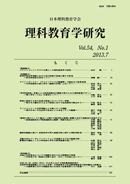Volume 54, Issue 3
Displaying 1-11 of 11 articles from this issue
- |<
- <
- 1
- >
- >|
Original Papers
-
2014Volume 54Issue 3 Pages 307-317
Published: March 18, 2014
Released on J-STAGE: April 24, 2014
Download PDF (1414K) -
2014Volume 54Issue 3 Pages 319-334
Published: March 18, 2014
Released on J-STAGE: April 24, 2014
Download PDF (4581K) -
2014Volume 54Issue 3 Pages 335-346
Published: March 18, 2014
Released on J-STAGE: April 24, 2014
Download PDF (1813K) -
2014Volume 54Issue 3 Pages 347-356
Published: March 18, 2014
Released on J-STAGE: April 24, 2014
Download PDF (736K) -
2014Volume 54Issue 3 Pages 357-367
Published: March 18, 2014
Released on J-STAGE: April 24, 2014
Download PDF (1643K) -
2014Volume 54Issue 3 Pages 369-382
Published: March 18, 2014
Released on J-STAGE: April 24, 2014
Download PDF (838K) -
2014Volume 54Issue 3 Pages 383-392
Published: March 18, 2014
Released on J-STAGE: April 24, 2014
Download PDF (2162K) -
2014Volume 54Issue 3 Pages 393-401
Published: March 18, 2014
Released on J-STAGE: April 24, 2014
Download PDF (3139K) -
2014Volume 54Issue 3 Pages 403-417
Published: March 18, 2014
Released on J-STAGE: April 24, 2014
Download PDF (2074K) -
2014Volume 54Issue 3 Pages 419-426
Published: March 18, 2014
Released on J-STAGE: April 24, 2014
Download PDF (1560K)
Note
-
2014Volume 54Issue 3 Pages 427-437
Published: March 18, 2014
Released on J-STAGE: April 24, 2014
Download PDF (2680K)
- |<
- <
- 1
- >
- >|
